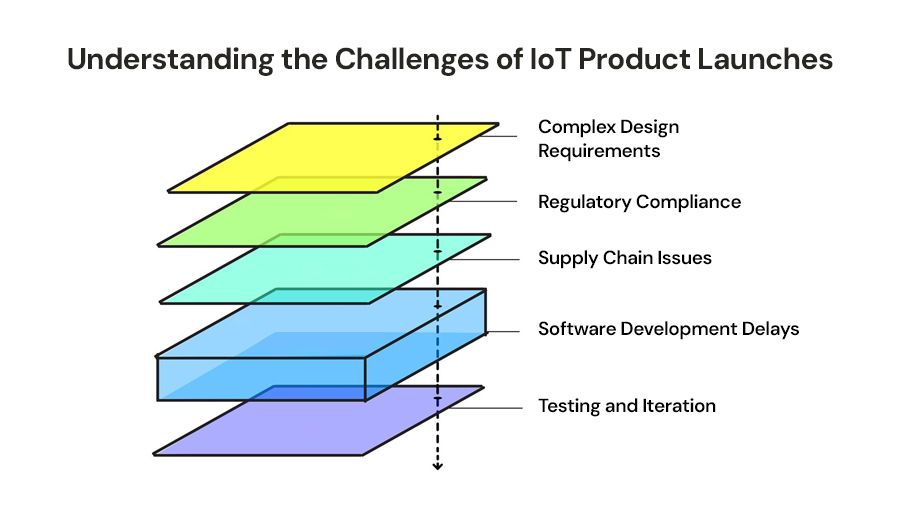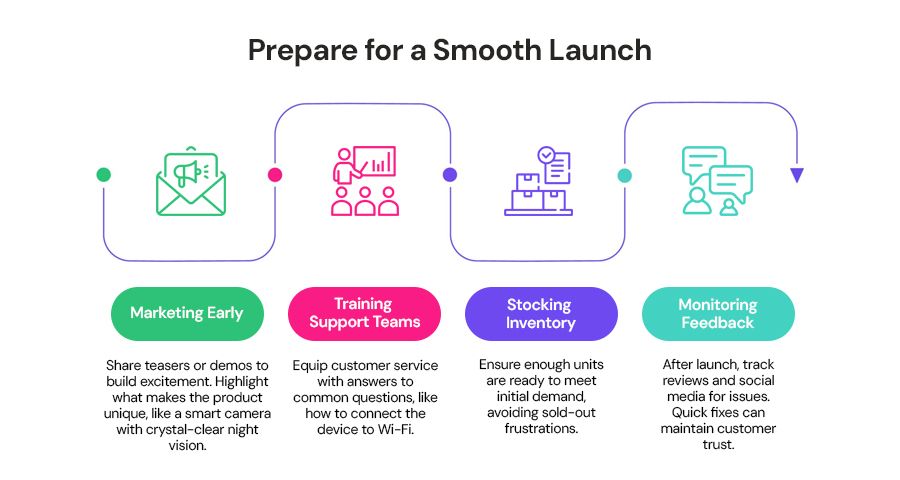
Imagine launching a smart home device that customers love, hitting the market months ahead of competitors. For smart home manufacturers, speed is everything—delays can mean lost sales and missed opportunities. By streamlining the product development process, companies can bring innovative Internet of Things (IoT) devices to market faster, meeting customer demands and staying competitive.
The smart home industry is growing rapidly, with devices like smart thermostats, lights, and security systems becoming household staples. However, launching these products is nosimple task. Manufacturers face challenges like complex hardware and software integration, strict regulations, and the need for flawless user experiences. Slow development cycles can lead to missed market windows, frustrated teams, and wasted resources. This article explores practical ways to accelerate IoT product launches, focusing on clear strategies that smart home manufacturers can adopt to save time and deliver quality products. From planning to partnerships with a software product development company, we’ll cover steps to make launches smoother and faster.
Understanding the Challenges of IoT Product Launches

Launching an IoT device involves coordinating multiple moving parts. Hardware must work seamlessly with software, and both need to meet high standards for security and performance. For smart home products, the stakes are even higher customers expect devices to be easy to use, reliable, and compatible with platforms like Alexa or Google Home. Delays often stem from common hurdles:
Complex Design Requirements: IoT devices require precise hardware and software integration. A single mismatch can cause malfunctions, forcing teams to restart testing.
Regulatory Compliance: Smart home devices must meet safety, privacy, and wireless communication standards, which vary by region. Navigating these rules takes time.
Supply Chain Issues: Sourcing components like sensors or chips can lead to bottlenecks, especially during global shortages.
Software Development Delays: Creating apps or cloud systems that connect devices to users is time-intensive, particularly if teams lack expertise.
Testing and Iteration: IoT products need rigorous testing to ensure they work in real-world conditions, such as spotty Wi-Fi or power fluctuations.
These challenges can stretch timelines from months to years. To speed up launches, manufacturers need a clear plan that tackles these issues head-on.
Step 1: Plan Early and Define Clear Goals
A fast product launch starts with a solid plan. Before any design or coding begins, manufacturers should define what success looks like. Is the goal to launch a smart doorbell with best-in-class video quality? Or a budget-friendly smart plug that works with every major platform? Clear goals keep teams focused and prevent wasted effort.
During planning, break the project into smaller milestones. For example:
Month 1: Finalize product features and hardware specs.
Month 2: Begin software design and prototype hardware.
Month 3: Test early prototypes and gather feedback.
Setting realistic timelines for each phase helps avoid surprises. It’s also important to involve all teams—hardware, software, and marketing—from the start. This ensures everyone understands the product’s purpose and can flag potential issues early.
Another key part of planning is understanding the customer. What do they want from a smart home device? Researching user needs, like preferring voice control or easy setup, shapes the product to meet market demands. By aligning features with customer expectations, manufacturers can avoid costly redesigns later.
Step 2: Streamline Hardware and Software Integration
For IoT devices, hardware and software must work together perfectly. A smart thermostat, for instance, needs sensors to detect temperature, firmware to process data, and an app for user control. Missteps in any of these areas can delay the entire project.
To speed up integration, manufacturers can adopt modular designs. This means building hardware and software in smaller, independent pieces that can be tested separately before combining them. For example, developing the thermostat’s sensor system apart from its Wi-Fi module allows teams to troubleshoot issues without halting the whole project.
Working with product development services can also save time. These services bring expertise in designing hardware and software that connect smoothly. Instead of struggling with unfamiliar tasks, like embedding Bluetooth in a device, manufacturers can rely on specialists to get it right the first time. This approach reduces errors and speeds up the path to a working prototype.
Step 3: Partner with a Software Product Development Company
Software is the backbone of any smart home device. It powers everything from device connectivity to user apps and cloud services. However, building reliable software in-house can be slow, especially for manufacturers focused on hardware.
Partnering with a software product development company is a practical solution. These companies specialize in creating apps, firmware, and cloud systems tailored to IoT products. For example, they can build an app that lets users control a smart light from their phone or a cloud platform that stores security camera footage. Their experience means faster development and fewer bugs.
When choosing a partner, look for one with a track record in IoT projects. Ask about their process—do they test software thoroughly? Can they integrate it with your hardware? A good software product development company will also prioritise security, ensuring devices are protected from hacks. By outsourcing software tasks, manufacturers can focus on their strengths, like designing innovative hardware, while keeping the project on track.
Step 4: Prioritize Testing Without Sacrificing Speed
Testing is critical for IoT products, but it’s often a bottleneck. Smart home devices must work in varied conditions—different Wi-Fi speeds, temperatures, or user behaviors. Thorough testing catches issues before launch, preventing recalls or bad reviews.
To test faster without cutting corners, use automated tools. For software, automated testing programs can simulate thousands of user interactions in hours, far quicker than manual checks. For hardware, stress tests can mimic months of use in days. These methods find problems early, saving time on fixes.
Another tip is to test incrementally. Instead of waiting until the product is complete, test each component as it’s built. For example, check the accuracy of a smart lock’s motion sensor before integrating it with the app. This catches issues early, avoiding major delays later.
Finally, involve real users in testing. Beta programs, where customers try pre-release devices, provide feedback on usability. If users find the app confusing, teams can tweak it before launch. This step ensures the product meets expectations without slowing progress.
Step 5: Navigate Regulations and Supply Chains Proactively
Regulations and supply chains are two areas where delays often creep in. Smart home devices must comply with rules on data privacy, wireless signals, and electrical safety. For example, the Federal Communications Commission (FCC) in the U.S. requires certification for devices using Wi-Fi or Bluetooth. Falling behind on these approvals can halt a launch.
To stay ahead, start the compliance process early. Work with legal or regulatory experts to understand requirements for each target market—U.S., Europe, Asia, etc. File for certifications as soon as hardware designs are finalized, rather than waiting for a finished product. This parallel approach saves months.
Supply chain issues, like chip shortages, can also derail timelines. To minimize risks, build relationships with multiple suppliers. If one can’t deliver, another can step in. Ordering components early, even before final designs, secures inventory and avoids last-minute scrambles. While this requires upfront investment, it keeps the project moving.
Step 6: Leverage Prototyping for Faster Feedback
Prototyping is a powerful way to accelerate development. By building early versions of the product, teams can test ideas and spot flaws quickly. For instance, a prototype of a smart speaker might reveal that its microphone struggles with background noise, prompting a redesign before mass production.
Rapid prototyping tools, like 3D printers for hardware or low-code platforms for software, make this process even faster. Manufacturers can create and test multiple versions in weeks, not months. Each prototype refines the product, ensuring the final version is polished and market ready.
Working with product development services during prototyping can further speed things up. These services often have access to advanced tools and expertise, helping teams iterate quickly. Whether it’s tweaking a circuit board or simplifying an app interface, their input reduces guesswork and accelerates progress.
Step 7: Prepare for a Smooth Launch
A fast development process means little if the launch itself stumbles. To ensure success, plan the rollout carefully. This includes:

Marketing Early: Share teasers or demos to build excitement. Highlight what makes the product unique, like a smart camera with crystal-clear night vision.
Training Support Teams: Equip customer service with answers to common questions, like how to connect the device to Wi-Fi.
Stocking Inventory: Ensure enough units are ready to meet initial demand, avoiding sold-out frustrations.
Monitoring Feedback: After launch, track reviews and social media for issues. Quick fixes can maintain customer trust.
A well-executed launch builds momentum, turning a speedy development process into real-world success.
The Benefits of Speeding Up IoT Launches
By adopting these strategies, smart home manufacturers can cut months off their timelines. Faster launches mean reaching customers sooner, capturing market share, and staying ahead of competitors. They also reduce costs—shorter projects use fewer resources. Most importantly, speed allows manufacturers to deliver products that delight users, building loyalty and driving sales.
For example, a company that launches a smart thermostat six months early can dominate the holiday shopping season, while competitors scramble to catch up. Pairing internal efforts with partnerships, like hiring a software product development company, makes this possible without sacrificing quality.
Conclusion
The smart home market is crowded and fast-moving, but manufacturers can stand out by launching IoT products quickly and efficiently. By planning carefully, streamlining integration, testing smartly, and partnering with experts in product development services, companies can overcome common delays. Navigating regulations and supply chains proactively further clears the path to market.
Speed doesn’t mean cutting corners—it means working smarter. With the right approach, smart home manufacturers can bring innovative, reliable devices to customers faster, turning ideas into reality in record time. The result? Happier customers, stronger sales, and a reputation for delivering what the market wants, when it wants it.
Launch Faster with IoT Development Experts


